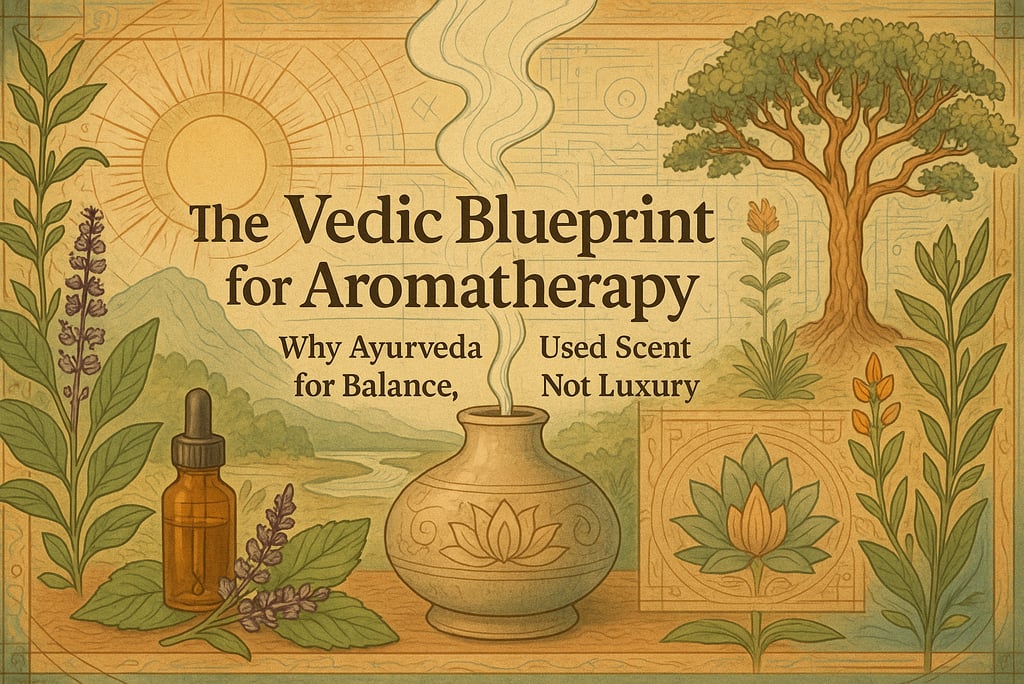The Vedic Blueprint for Aromatherapy: Why Ayurveda Used Scent for Balance, Not Luxury
Rediscovering how ancient Ayurvedic wisdom can make our modern use of essential oils more effective
THE SCENT DAILY
7/24/20256 min read
Ayurveda didn’t treat scent as indulgence—it treated it as precision. Long before modern aromatherapy, Vedic philosophy embedded fragrance into daily rituals as a means of restoring physiological and emotional balance. This piece explores how reintroducing that logic—using oils not based on mood or marketing, but timing, constitution, and method—can help us unlock the true power of essential oils in everyday life.
Ayurveda viewed scent as medicine, not luxury
Essential oils work best when matched to dosha, time, and delivery method
Modern aromatherapy often forgets the framework that gives scent its strength
Applying Ayurvedic logic can make aromatherapy more effective, more personal, and more respectful of both plant and person
Overview


You lit the diffuser, watched the lavender‑hued mist curl into the bedroom air, and still spent half the night scrolling through thoughts that refused to dim. If essential oils are the miracle everyone claims, why do they so often feel like scented placebos? The answer, we believe, is less about the oil itself and more about the framework guiding its use. Long before “aromatherapy” appeared on spa menus, Ayurveda treated scent as a calibrated instrument for equilibrium. It never burned incense for ambience alone; it inhaled botanical molecules to fine‑tune mind and body. Modern wellness culture remembers the fragrance but forgets the formula—and that oversight dulls the power locked inside every vial on your shelf.
We have, in effect, inherited the violin without the sheet music. Bottles of frankincense, tulsi, or bergamot sit on bathroom counters worldwide, yet few users can explain why frankincense steadies ragged breathing while bergamot lifts winter moods beyond pleasant aroma. Ayurveda could. It mapped each scent to specific imbalances, times of day, and personal constitutions. In doing so, it offered a blueprint—drawn from Vedic philosophy—that today’s casual aromatherapy ignores. Re‑embracing that blueprint, not romanticizing ancient rituals, is what will make essential oils truly effective in contemporary life.
Walk through any upscale retailer and you will find lavender marketed for peace, peppermint for energy, sandalwood for “spiritual vibes,” all delivered in identically sleek droppers. The assumption is universal benefit: choose the aroma you like, diffuse at will, expect transformation. Influence campaigns inflate the promise, and the global essential‑oil market—projected to pass USD 18 billion by 2030—thrives on impulse scent shopping. Yet clinical results remain uneven because application is scatter‑shot. Customers buy a relaxing blend, place it next to a bright phone screen at 11 p.m., then wonder why their mind races toward morning emails. The oil is not failing; the context is.
Ayurveda explains that problem in terms of dosha—three underlying mind‑body forces that shape how we experience the world. Vata is light and airy, responsible for quick thoughts and cold hands; Pitta is fiery and sharp, driving focus yet also irritation; Kapha is earthy and steady, providing stamina but prone to heaviness. Classical treatises such as the Charaka Samhita group fragrance (gandha) under the earth element because aroma can anchor the nervous system. But it anchors only when its character counterbalances the dosha that’s flaring: a warming resin like myrrh reins in restless Vata, a cooling rose mist calms overheated Pitta, and a bracing whiff of tulsi rouses sluggish Kapha. In short, scent in Ayurveda is not decoration; it’s dosage.
Why does that prescription work? Neuroscience is catching up. A 2022 review in Frontiers in Neuroscience confirmed that volatile plant molecules reach the limbic system—the brain’s emotional hub—in milliseconds, bypassing slower cortical gatekeepers. Linalool, the main compound in lavender, modulates GABA‑A receptors implicated in anxiety regulation; β‑caryophyllene in copaiba interacts with CB2 cannabinoid receptors linked to inflammation. Ayurveda, lacking micrographs, nevertheless inferred these pathways by observing how certain fumes steadied breath, softened pulse, or sharpened meditation focus. Its epistemology differs from double‑blind trials, but its practical outcomes rhyme with them.
Translating that wisdom into today’s life requires three adjustments: timing, personalisation, and medium.
Consider timing first. Vata‑pacifying scents such as vetiver and jatamansi are most effective at night, when their heavy, earthy profile counters the sleepless restlessness that peaks after 10 p.m. (Ayurvedic physicians place that window in the “vata stage” of the daily circadian cycle.) Diffusing peppermint at that hour, on the other hand, stirs rather than settles. Flip the clock to dawn and the logic reverses: 6 a.m. is kapha‑dominated—slow, sticky, foggy—so invigorating eucalyptus smoke or a brisk nasya (nasal oil) with brahmi wakes cognition without caffeine jitters. The oil’s chemistry has not changed; the body’s receptivity has.
Personalisation is next. A marketing graphic cannot know whether you run cold, hot, or damp inside. Ayurveda can—and does so with a simple doshic self‑assessment. Someone prone to cold limbs, jumpy thoughts, and cracking joints (classic Vata) benefits from thicker, resinous aromas diluted in sesame oil. A fiery, decisive personality who overheats under deadlines (Pitta) leans on rose, sandalwood, or kewda in a cooling base like coconut. A slow‑moving, water‑retaining Kapha thrives on stimulating camphoraceous herbs in mustard oil. When oils are matched this way, users report deep shifts rather than surface mood lifts. We have watched clients swap generic “stress blends” for vetiver‑jatamansi balms and see decades‑old insomnia ease within a week.
The final bridge is medium: how scent is delivered. Ancient Vedic practice favored dhupana—fumigating rooms with smoldering resins—to cleanse collective spaces; gandusha (herbal oil pulling) to awaken oral‑nasal pathways; and nasya, a direct instillation of medicated oils into the nostrils, to move molecules past the cribriform plate and into the brain’s front door. Today, a simple steam bowl can approximate nasya’s warming effects. Five drops of tulsi in hot water, head draped, five deep breaths: sinuses clear, focus sharpens. A beeswax candle laced with guggul can echo dhupana for shared living rooms, replacing synthetic aerosols that mask odor rather than harmonise energy.
Sceptics may bristle at words like energy or balance, but they need not discard the protocol. Scanning studies at Kyoto University show that vetiver’s sesquiterpenes slow EEG beta waves, mirroring the calm Ayurveda attributes to grounding scents. Research at the University of Vienna demonstrates that rose oxide suppresses cortisol spikes under social stress, lending laboratory support to Pitta‑cooling claims. When fields converge—empirical Ayurveda, analytical chemistry, neurobiology—the result is neither mysticism nor pure biochemistry; it is a fuller picture of how humans co‑evolved with aromatic plants.
So how do we reclaim that picture in practice? Start with a single week‑long experiment. Tonight, before bed, warm a teaspoon of sesame oil, add two drops of vetiver, and massage a half‑drop just inside each nostril. Lie down, left side, and breathe through your nose for thirty seconds. Note how the mind’s chatter shifts. Tomorrow at dawn, boil water, drop in three crushed tulsi leaves or one drop of tulsi essential oil, tent a towel, and inhale for ten breaths. Move through the day observing whether mental clarity outlasts your usual mid‑morning slump. On day three, replace the tulsi steam with a few grains of frankincense resin on a charcoal disk during meditation. Keep journaling. By day seven, patterns emerge: which aroma grounds, which lifts, which times amplify each effect. That is Ayurveda’s method—iterative, experiential, precise.
None of this demands a return to temple rituals or Sanskrit recitation. It demands, instead, a mindset shift: from collecting oils like luxury stamps to wielding them like calibrated instruments. Used this way, aromatherapy consumes fewer raw materials—one drop, not ten—and honours plant sources by avoiding over‑diffusion. It also frees users from scent fads driven by packaging aesthetics rather than physiological need. The payoff is ecological and personal: reduced waste, enhanced effect, deeper respect.
We often tell readers that fragrance is identity. Ayurveda would say it is alignment. A lavender cloud floating above a bright smartphone cannot override blue‑light agitation; a rose‑jasmine pillow spray at noon may lull a Pitta‑driven professional into premature lethargy. But place each aroma where the body’s clock and constitution invite it, and the same molecules become targeted medicine. We have the bottles. The Vedic blueprint hands us the map.
Tonight, perhaps, the diffuser will run only three minutes, long enough for vetiver’s earthy whisper to anchor your breath—then darkness, then rest. Balance has a scent; we only need to remember how to breathe it in.
The Read
Ayurveda didn’t treat scent as indulgence—it treated it as precision. Long before modern aromatherapy, Vedic philosophy embedded fragrance into daily rituals as a means of restoring physiological and emotional balance. This piece explores how reintroducing that logic—using oils not based on mood or marketing, but timing, constitution, and method—can help us unlock the true power of essential oils in everyday life.
Ayurveda viewed scent as medicine, not luxury
Essential oils work best when matched to dosha, time, and delivery method
Modern aromatherapy often forgets the framework that gives scent its strength
Applying Ayurvedic logic can make aromatherapy more effective, more personal, and more respectful of both plant and person


